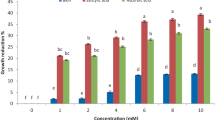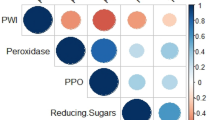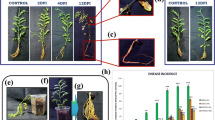Abstract
Differential expression of catalase isozymes in different genotypes of chickpea resistant genotypes- A1, JG-315, JG-11, WR-315, R1-315, Vijaya, ICCV-15017, GBS-964, GBM-10, and susceptible genotypes- JG-62, MNK, ICCV-08321, ICCV-08311, KW-104, ICCV-08123, ICC-4951, ICC-11322, ICC-08116 for wilt disease caused by Fusarium oxysporum. f. sp. ciceri (Foc) was analyzed. Salicylic acid (SA) and H2O2 concentrations were determined in control as well as in plants infected with F. ciceri and found that the high and low levels of salicylic acid and H2O2 in resistant and susceptible genotypes of chickpea respectively. Catalase isozyme activities were detected in the gel and found that no induction of new catalases was observed in all the resistant genotypes and their some of the native catalase isozymes were inhibited; whereas, induction of multiple catalase isozymes was observed in all the screened susceptible genotypes and their activities were not inhibited upon Foc or SA treatments. The above results support the possible role of these isozymes as a marker to identify which genotype of chickpea is expressing systemic acquired resistance.


Similar content being viewed by others
Abbreviations
- Foc:
-
Fusarium oxysporum f. sp. ciceri
- SA:
-
Salicylic acid
References
Barbehenn R, Dukatz C, Holt C, Reese AO, Salminen JP (2010) Feeding on poplar leaves by caterpillars potentiates foliar peroxidase action in their guts and increase plant resistance. Oecologia 164:993–1004
Chen Z, Klessig DF (1991) Identification of a soluble salicylic acid binding protein that may function in signal transduction in the plant disease resistance response. Proc Natl Acad Sci U S A 88:8179–8183
Chen Z, Riciglano JW, Klessig DF (1993) Purification and characterization of a soluble salicylic acid binding protein from tobacco. Proc Natl Acad Sci U S A 90:9533–9537
Dempsey DM, Klessig DF (1994) Salicylic acid, active oxygen species and systemic acquired resistance in plants. Trends Cell Biol 4:334–338
Dixon RA, Lamb CJ (1990) Molecular communication in interaction between plants and microbial pathogens. Annu Rev Plant Physiol Plant Mol Biol 41:339–367
Durner J, Shah J, Klessig DF (1997) Salicylic acid and disease resistance in plants. Trends Plant Sci 7(2):266–274
Ganesan V, Thomas G (2001) Salicylic acid response in rice: influence of salicylic acid on H2O2 accumulation and oxidative stress. Plant Sci 160:1095–1106
Gayatridevi S, Jayalakshmi SK, Sreeramulu K (2012) Salicylic acid is a modulator of catalase isozymes in chickpea plants infected with Fusarium Oxysporum f. sp. ciceri. Plant Physiol Biochem 52:154–161
Hayat Q, Hayat S, Irfan M, Ahmad A (2009) Effect of exogenous salicylic acid under changing environment. Environ Exp Bot 68:14–25
Hennig J, Malamy J, Grynkiewicz O, Indulski J, Klessig DF (1993) Interconversion of the salicylic acid signal and its gluco ide in tobacco. Plant J 4:593–600
Howe GA, Jander G (2008) Plant immunity to herbivores. Annu Rev Plant Biol 59:41–66
Kawano T (2003) Roles of reactive oxygen species generating peroxidase reactions in plant defense and growth induction. Plant Cell Rep 21:829–837
Klessig DF, Malamy J (1994) The salicylic acid signal in plants. Plant Mol Biol 26:1–20
Klessig DF, Durner J, Noad R, Navarre DA, Wendehenne D, Kumar D, Zhou JM, Shah J, Zhang S, Kachroo P (2000) Nitric oxide and salicylic acid signaling in plant defense. Proc Natl Acad Sci U S A 97:8849–8855
Kokat Z, Burda K (1998) Simultaneous determination of salicylic acid and acetylsalicylic acid in aspirin delayed-release tablet formulations by second-derivative UV spectrophotometry. J Pharma Biochem Anal 18:871–875
Laemmli UK (1970) Cleavage of structural proteins during the assembly of the head of bacteriophage T4. Nature 227:680–685
Lowry OH, Rosebrough NJ, Farr AL, Randall RJ (1951) Protein measurement with folin phenol reagent. J Biol Chem 193:265–275
Lu H (2009) Dissection of salicylic acid-mediated defense signaling networks. Plant Signal Behav 4:713–717
Maffei ME, Mithofer A, Boland W (2007) Insects feeding on plants: rapid signals and responses preceding the induction of phytochemical release. Phytochemistry 68:2946–2959
Malamy J, Hennig J, Klessig DF (1992) Temperature dependent induction of salicylic acid and its conjugates during the resistance response to tobacco mosaic virus infection. Plant Cell 4:359–366
Martha L, Orozco C, Javier NV, Clarence AR (2001) Hydrogen peroxide acts as a second messenger for the induction of defense genes in tomato plants in response to wounding, systemin and methyl jasmonate. Plant Cell 13:179–191
Mohd I, Naeem M, Tariq A, Masroor M, Khan A (2011) Salicylic acid mitigates salinity stress by improving antioxidant defense system and enhances vincristine and vinblastine alkaloids production in periwinkle. Acta Physiol Plant 33:987–999
Noreen Z, Ashraf M (2009) Change in antioxidant enzymes and some key metabolites in some genetically diverse cultivars of radish (Raphanus sativus L.). Environ Exp Bot 67:395–402
Raju S, Jayalakshmi SK, Sreeramulu K (2007) Induction of systemic acquired resistance in susceptible and resistance cultivars of chickpea genotypes. Physiol Mol Biol Plant 13:27–36
Raju S, Jayalakshmi SK, Sreeramulu K (2008) Comparative study on the induction of defense related enzymes in two different cultivars of chickpea (Cicer arietinm L.) genotypes by salicylic acid, spermine and Fusarium oxysporum f. sp. ciceri. Aust J Crop Sci 2(3):121–140
Rao MV, Paliyath G, Ormond DP, Dennis PO, Murr DP, Watkins CB (1997) Influence of salicylic acid on H2O2 production oxidative stress and H2O2 metabolizing enzymes. Plant Physiol 115:137–149
Ryals JA, Neuenschwander UH, Willits MG, Molina A, Steiner HY, Hunt MB (1996) Systemic acquired resistance. Plant Cell 8:1809–1819
Sanchez-casas P, Klessing DF (1994) A salicylic acid binding activity and a acid inhibitable catalase activity is present in a variety of plant species. Plant Physiol 106:1675–1679
Vicent MRS, Plasencia J (2011) Salicylic acid beyond defense: it’s role in plant growth and development. J Exp Bot 62:3321–3338
War AR, Paulraj MG, War MY, Ignacimuthu S (2011) Herbivore and elicitor induced resistance in groundnut to asian armyworm, Spodoptera litura. Plant Signal Behav 6:1769–1777
Wendenhenne D, Durner J, Chen Z, Klessig D (1998) Benzothiadiazole, an inducer of plant defenses, inhibits catalase and ascorbate peroxidase. Phytochemistry 47:651–657
Woodbury W, Spencer AK, Stahman MA (1971) An improved procedure for ferricyanide for detecting catalase isozymes. Anal Biochem 44:301–305
Acknowledgments
This research was supported by research grants to KS from DST and UGC-SAP, the Government of India, New Delhi. GS thanks Gulbarga University, Gulbarga and UGC for financial assistance in the form of student fellowship during this work.
Author information
Authors and Affiliations
Corresponding author
Rights and permissions
About this article
Cite this article
Gayatridevi, S., Jayalakshmi, S.K., Mulimani, V.H. et al. Salicylic acid and salicylic acid sensitive and insensitive catalases in different genotypes of chickpea against Fusarium oxysporum f. sp. ciceri . Physiol Mol Biol Plants 19, 529–536 (2013). https://doi.org/10.1007/s12298-013-0184-4
Published:
Issue Date:
DOI: https://doi.org/10.1007/s12298-013-0184-4




